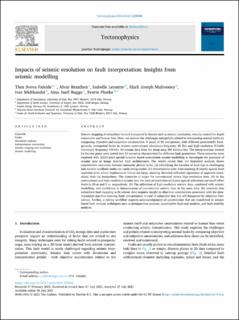| dc.contributor.author | Faleide, Thea Sveva | |
| dc.contributor.author | Braathen, Alvar | |
| dc.contributor.author | Lecomte, Isabelle Christine | |
| dc.contributor.author | Mulrooney, Mark Joseph | |
| dc.contributor.author | Midtkandal, Ivar | |
| dc.contributor.author | Bugge, Aina J. | |
| dc.contributor.author | Planke, Sverre | |
| dc.date.accessioned | 2022-01-18T09:38:39Z | |
| dc.date.available | 2022-01-18T09:38:39Z | |
| dc.date.created | 2021-08-18T09:00:48Z | |
| dc.date.issued | 2021 | |
| dc.identifier.issn | 0040-1951 | |
| dc.identifier.uri | https://hdl.handle.net/11250/2837849 | |
| dc.description.abstract | Seismic mapping of subsurface faults is hampered by factors such as seismic resolution, velocity control for depth conversion and human bias. Here, we explore the challenges and pitfalls related to interpreting normal faults by comparing objective and subjective uncertainties. A panel of 20 interpreters, with different geoscientific backgrounds, interpreted faults in modern conventional (dominant frequency 40 Hz) and high-resolution P-Cable (dominant frequency 150 Hz) 3D seismic data from the Hoop area, SW Barents Sea. The interpretations created by the test-panel were sorted into 10 scenarios characterized by different fault geometries. These scenarios were explored with 2(3)D point-spread function based convolution seismic modelling to investigate the potential of seismic data to image detailed fault architectures. The results reveal that: (1) Statistical analysis shows considerable variations between manually picked faults. (2) Identifying the location of fault tips is challenging and smaller antithetic faults are rarely recognizable. (3) Uncertainties arise from masking of closely spaced fault segments even where displacement values are large, showing distorted reflection signatures of apparent extensional fault tip monoclines. The distortion is larger for conventional versus high-resolution data. (4) In the conventional and high-resolution seismic data the vertical resolution of closely spaced reflections and small offset faults is 20 m and 5 m, respectively. (5) The utilisation of high-resolution seismic data, combined with seismic modelling, add confidence to interpretation of conventional seismic data in the same area. We conclude that subsurface fault mapping with seismic data requires insight in objective uncertainties associated with the data. Automatic machine-learning fault interpretation is void of subjective bias but still hampered by objective limitations. Further, a risking workflow requires acknowledgement of uncertainties that are transferred to seismic based fault analysis techniques such as juxtaposition analysis, quantitative fault seal analysis, and fault stability analysis. | en_US |
| dc.language.iso | eng | en_US |
| dc.publisher | Elsevier | en_US |
| dc.relation.uri | https://doi.org/10.1016/j.tecto.2021.229008 | |
| dc.rights | Navngivelse 4.0 Internasjonal | * |
| dc.rights.uri | http://creativecommons.org/licenses/by/4.0/deed.no | * |
| dc.title | Impacts of seismic resolution on fault interpretation: Insights from seismic modelling | en_US |
| dc.type | Journal article | en_US |
| dc.type | Peer reviewed | en_US |
| dc.description.version | publishedVersion | en_US |
| dc.rights.holder | Copyright 2021 The Authors | en_US |
| dc.source.articlenumber | 229008 | en_US |
| cristin.ispublished | true | |
| cristin.fulltext | original | |
| cristin.qualitycode | 1 | |
| dc.identifier.doi | 10.1016/j.tecto.2021.229008 | |
| dc.identifier.cristin | 1926820 | |
| dc.source.journal | Tectonophysics | en_US |
| dc.identifier.citation | Tectonophysics. 2021, 816, 229008. | en_US |
| dc.source.volume | 816 | en_US |

